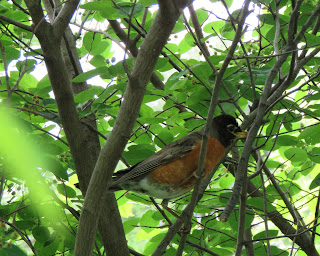New York Botanical Garden's Native Plant Garden on May 29, 2016
guest post by Joel Nevis y Flores
I did not give a tour but was at the NYBG with friends enjoying their rose garden among other things. Grass pollens had arrived and I briefly lost my voice to allergy coughing. The temperature reached 93F and the weather was beautifully sunny despite the forecasts. The robin's nest in the shadbush from last week appeared empty and we noticed an immature robin not far away by the native border.
 |
| Plenty of visitors at the NPG entrance |
 |
| Fledgling American robin |
Most of the spring ephemerals have finished their floral display; consequently visitors sped through the woodland garden rather quickly, often failing to note such late bloomers as Kentucky lady slipper. On the other hand the sarracenias looking very colorful in the wetland garden; it is would be smart to find that sign about carnivorous plants from last year (or was it the previous year) to turn a pretty flower experience into a learning experience.
Amsonia
Anemonella thalictroides
Aquilegia canadensis
Asarum canadense
Baptisia australis
Baptisia carolina “Moonlight”
Baptisia alba
Calycanthus floridus
Carex muskingumensis
Carex plantaginea
Cerastium arvense
Chionanthus virginicus
Clematis ochroleuca (flower and seed)
Comptonia peregrina
Coreopsis
Cornus sericea in the rear of the native border
Cypripedium kentuckiense
 |
| Cypripedium kentuckiense |
Diphylleia cymosa
Erigeron pulchellus
Geranium maculatum
Geum trifolium Prairie Smoke seeds
Gillenia trifoliata
Heuchera longiflora
Hybrid Pitcher Plant Sarracenia x areolata
 |
| Hybrid Pitcher Plant Sarracenia x areolata |
Iris prismatica
Juncus effusus
Kalmia angustifolia
Leucothoe axillaris
Magnolia virginiana
Maianthemum (Canada Mayflower)
Meehania cordata maybe
 |
| Is this Meehania cordata? |
Monarda bradburiana
Orontium aquaticum - flower spikes are slipping below the waterline so I assume they are nearing the end of the blooming phase
Osmorhiza claytonii
Osmunda regalis
Osmundastrum cinnamomeum
Parthenium integrifolium
Penstemon digitalis
Penstemon hirsitus in both dwarf and regular forms
Phacelia bipinnatifolia
Polemonium
Polemonium reptans “Touch of Class”
Polygonatum
Primula meadia - a few still around
Rhododendon "Choptank rose"
Rhododendron “Catawbiense Album”
 |
| Rhododendron “Catawbiense Album” |
Rhododentron "Marydel"
Sarracenia alata
Sarracenia flava
Sarracenia leucophylla
Sedum nevii
Sisyrinchium angustifolium
Smilacina racemosa
Stylophorum diphyllum
Tiarella
Tradescantia - flowers were closed in the full sunlight as they like to do; you need to see them in the morning or on a cloudy day
Trillium recurvatum
Trillium flexipes
Trillium luteum
Vaccinium are forming loads of fruit that the birds will enjoy
Vicia
 |
| Vicia (Cow vetch) |
Viola walteri
Zizia
A few mysteries to me. The first may be cardamine -- the flowers look like it and the leaves were weakly toothed.
 |
| May be cardamine |
 |
| in the meadow |
 |
| in the wet woodland not far from the boardwalk |
The non-native, invasive Chelidonium majus (Celandine) is going to seed over by the river birch screen. And the Rumex acetosa (red sorrel), though no longer in bloom, were thriving.
next post
first post in blog
































